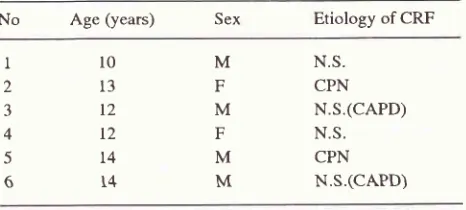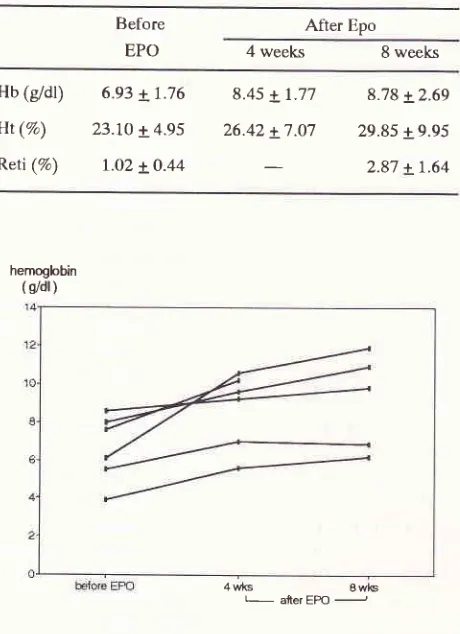Recombinant Human
Erythropoetin
(A
Preliminary
Report)
Husein AlatasChildren
with
Chronic Renal
Failure
ln
Abstrak
Abstract
Keywords : R-Hu-Epo, Chronic renal failure, Attetrtia, Hypertension
INTRODUCTION
Anemia
is one
of the major complications
in
renal failure, which leads to the necessity of repeated blood transfusions and the consequent risks and complica_tions.
Regularblood tranifusion may
correct the anemia temporarily,but
as mentioned before,it
is associatedwith
certain risks such as iron overload,transmission of viral infections, and ilcreased produc-tion of lymphocytotoxic antibodies. 1,3
Recently, recombinant human erythropoetin (r_ Hu-Epo) has been made availaUte.
Ànimal
"^p"ii_ ments have shown
it to
be
effectivein
correcting anemia in chronic renal failure. Recent trials on adults and childrenreceiving
hemodialysisor
peritoneal dialysis as maintenance therapy have showï prompt94
Alatasresolution
of
anemia after administrationof
r-Hu-Epo.u't Hypertension has been the most frequently reported side effectin r-Hu-Epo
therapy, butin
the majorityof
the patients, blood pressule^ was easilycontrolled by adding hypotensive drugs.E'e
The purpose
of this
study is to evaluate theef-ficacy and safety
of
r-Hu-Epoin 6
children with anemia due to chronic renal failure. Changes in hemo-globin and hematocrit levels, reticulocyte count as wellas serum ferritin level were correlated to the r-Hu-Epo administration. Potential side effects were noted,
espe-cially changes in blood pressure which have frequently
been reported in the literature.'
MATERIALS
AND METHODSSix patients, consisting of 4 males and 2 females with a mean age
of
12,5 years, were entered in this study after parental informed consent were obtained (table1). The patients were all diagnosed as chronic renal
failure with a creatinine clearance of < 30 ml/min/1.73
-2. T*o
of these children suffered from terminal renal failure (creatinine clearance < 5 ml/min/1 .73 m2) and wason
continuous ambulatory peritoneal dialysis(CAPD)
treatment.
The
etiology was nephroticsyndrome in 4 patients and chronic pyelonephritis in 2
patients,
Theinclusion
criteriafor
r-Hu-Epo ad-ministration were:1. age
between 1-
16 years2.
no other
causesof anemia,
such as thallasemia, sickle cell anemia, etc.3.
no persistent severe hypertension4.
no abnormal liver functionThe drug was injected subcutaneously
with
a starting doseof
150 p/kgBW weekly for 4 successive weeks whilewaiting
for
a
response. An increase of 1 g/dl/month was a suitable guidelinefor
adequate response. The dose was then titratedby
adding 75p/kgBW/week and maintained for a further 4
succes-sive weeks. When the target hemoglobin of 10 g/dl was
reached, the titration phase was concluded and the r-Hu-Epo dose was maintained at this level.
Laboratory tests to evaluate renal and liver func-tions, serum ferritin, hemoglobin (Hb) and hematocrit levels (Ht), and reticulocyte count were recorded as baseline data.
After r-Hu-Epo
therapy was initiated, the Hb, Ht, and reticulocyte count were repeated everytwo
weeks, while serum ferritin levels were re-ex-amined after4
weeks and at the endof
drug level titration. Blood chemistry was evaluated monthly to monitor renal and liver functions. Ironsupplementa-tion was given during treatment, to maintain the ferritin
Med J Univ Indon
level within a normal range. Any patient can receive
blood transfusion when necessary.
. Potential side effects were noted during treat-ment. Blood pressure was carefully measured prior to and
30 minutes
after r-Hu-Epo injection.
It
wasmonitored daily in the hospitalized patients or biweek-ly in ambulatory patients on follow up examinations.
The quality
of life
was recorded monthly bymeans of a questionaire to observe any improvement or deterioration of the well being of the patients.
Spe-cial emphasis was made on the changes
in
appetite,physical fitness and school attendance.
Statistical significance
(p value) for
the paired data was not calculated, since the number of patientsin
this preliminary report was small. Values are ex-pressed as mean + SD.Table t. Clinical data of patients at the time of entry
No
Age(years)
Sex Etiology of CRFll0
213
312
412
514
614
M
N.S.F
CPNM
N.S.(CAPD)F
N.S.M
CPNM
N.S.(CAPD)NS
: Nephrotic Syndrome CPN : Chronic PyelonephritisRESULTS
The preliminary results of this study showed that in the first 4 and 8 weeks of r-Hu-Epo administration, the Hb, Ht, and reticulocyte count wete increased in all patients
(fig.
1,2,3). Hemoglobin levels rose from 6.93 + 1.76g/dl to 8.45 + L.77 gldl after 4 weeks and 8.78 + 2.69 after 8 weeks of treatment. Hematocrit levels rose from 23.10 + 4.95 % to 26.42 + 7.07 70 arTer 4 weeks and 29.85 + 9.95 7o after 8 weeks of treatment. Reticulo-cyte count rose from l.O2 + O.44 % to 2.87 + 1.64 % after 8 weeks
of
therapy (table 2). In 2 patients who required multiple blood transfusion prior to treatment, no further transfusions were needed after r-Hu-Epo administration.Increased
blood pressure
was observedin
2 patients. However, the blood pressure could be con-trolled by adding the antihypertensive drug captopril and reducing the r-Hu-Epo doseto the level
of
the preceeding week (figure 4). [image:2.595.306.539.317.422.2]Table
2.
The effectsoI
treatmentwith
r-Hu-Epo onbemoglobi n, hematocrit and reticulocyte count retiqJlocyte
[image:3.595.318.535.99.281.2](%')
Figure 3. Reticulocyte count before and during treatment with r-Hu-Epo
ferritin ng/ml
1 000
Before EPO
After Epo
4 weeks 8 weeks
Hb
(gdl)
6.e3 + 7.76Ht
(Va)
23.7O + 4.95Reti
(%)
I.o2 LO.448.45 +
1.77
8.78 + 2.6926.42 +
7.07
29.85 + 9.952.87 + 1.64
hemoglobin
( s/dl )
4 wks I wls
[image:3.595.54.284.114.431.2] [image:3.595.314.535.342.536.2] [image:3.595.58.275.507.685.2]L atterEPO J
Figure 1. Hemoglobin concentration before and during
treat-ment with r-Hu- Epo
hematocril
(wl%)
4 rrIG I wlG
L
aterEPO-Figure 2. Hematocrit values before and during treatment with r-Hu-Epo
-be{ore EPOFigure 4. Ferritin level before and during treatment with r-Hu-Epo
DISCUSSION
The synthesis
of
recombinant human erythropoetin(r-Hu-Epo) is a significant advantage in the treatment
of anemia due to chronic renal failure. Earlier studies
reported promising results
in
the treatmentof
renalanemia
in
hemodialyzed patients.4'5,10 More recent reports described the use of this drug in children as rwell96
AlatasEither intravenous
or
subcutaneousadministra-tion, which is clearly more practical in predialysis and
CAPD patients, produced no significant difference in
the pharmacokinitic or efficacy evaluation. I
I
In
thisstudy, r-Hu-Epo was administered to 4 predialysed and
2 CAPD patients, The results showed an increase in Hb
and
Ht
levels, aswell
as reticulocyte count. Thisdemonstrated that subcutaneous r-Hu-Epo was
effec-tive.
In
2
cases previously requiring multiple bloodtransfusions, no further transfusion needed to be given, thus preventing the dangers of hepatitis, AIDS, hemo-siderosis, or sensitization
of HLA
histocompatibility antigens.Several studies have confirmed the efficacy of
r-Hu-Epo
in
improving anemiain
end stage renalfailure patients not yet requiring dialysis therapy. Lim
et altreated 14 anemic patients with intravenous
r-Hu-Epo
in
a
doubleblind
placebo-controlledtrial
andreported an increase in mean hemoglobin levels from 9.1 + O.2 (se)
to
I2.3 + O.4 g/dl over à 2 month period.6 Escbach etal
had administered r-Hu-Epoin
17pre-dialysis patients with anemia and observed a median
rise of hematocrit from O.2'7 to O.37 .7
It is important to measure the serum iron level in
patients treated with r-Hu-Epo.
In
patients with irondeficiency, indicated by a low level of serum ferritin,
ferrum should be
supplementedeither
orally
orparenterally,
in
conjunction with r-Hu-Epo. This en-sures iron is adequate for the production of erytrocytes in the bone marrow. Findings in this study showed that serum ferritin level decreased and reticulocyte count increased during r-Hu-Epo treatment, which indicated that ferrum was utilizedfor
erytrocyte production inthe bone marrow. As was recommended, ferrous
sul-fate was administered orally
in
3 cases with normalserum ferritin level. Patients with repleted iron levels
can develop
iron
deficiency under the influence ofr-Hu-Epo.l)'13
Partial correction
of
anemiain
chronic renalfailure
with
r-Hu-Epois
the best treatment, since alinear increase in the hemoglobin and hematocrit levels leads to an exponential rise in whole body viscosity.14
This is thought to contribute to many side effects in
r-Hu-Epo therapy, such as hypertension, increased
peripheral resistance and thrombotic complication.
Based on this consideration a rise
of
L gldll4 weeks appears to be the best compromise and the optimum target of hemoglobin level seems to be in a range of10-12 g/dl.t5
The target Hb level in this study was set at 10 g/dl
as the end point
of
the r-Hu-Epo titration dose. Thisminimizes possible complications of treatment. Never-theless,
2
casesof
moderate hypertension wasob-Med J Univ Indon
served. However, a combination
of
captopril and re-ducing r-Hu-Epo dose by 75 p/kgBW/ week orreturn-ing to the dosage of the previous week was sufficient to control the blood pressure. No other side effects was observed in this study.
Hypertension was indeed the most frequently re-ported side effect associated with r-Hu-Epo th..upy.t'n
Results
of
multicenterclinical trials
involving 309patients showed that727o patients with existing hyper-tension were in no greater risk of acquiring increased
blood pressure than those who were nornotensive at
the beginning of treatment. Only 39% of the patients were reported as having developed sustained increase
in diastàlic pressure
of
to
--Hg
or more.16 Thein-creased blood pressure in r-Hu-Epo therapy is thought to be mediated by a number of pathophysiologic chan-ges namely increased blood viscosity, increased peri-pheral resistance, and failure in reducing the elevated cardiac output due to anemia.l6
Almost
all
children showed improved appetiteand physical activities. This along with a significant
increase in Hb were also reported by Suhardjono et "al
in their study on adult patients receiving r-Hu-Epo."
Data
from this
preliminaryclinical
trial
haveshown that r-Hu-Epo has promising effect in increas-ing the Hb and Ht levels in children with anemia due
to chronic renal failure. This minimizes multiple blood transfusions and the adverse effects caused. The high cost, however, limits the widespread use of this drug.
Acknowledgement
The author is grateful to Janssen Research
Coun-cil
Indonesiafor
their support in providing ther-Hu-Epo drugs in this clinical trial.
REFERENCES
l.
Savazzi GM. Pathogenesis of cerebral atrophy in uremia. Nephron 1988; 49 : 94-103.2. Scharer K, Muller-Wiefel D. Hematological complications.
Complications in Renal Failure in Holiday, Banatt, Vernier.
eds. Pediatric Nephrology. 2nd Ed. Baltimore : Williams &
Wilkins, 1987;880-7.
3. Winearls CG, Oliver DO, Pippard MJ, Reid C, Downing
MR, Cotes PM. Effects of human erythropoetin derived from
recombinant DNA on the anaemia of patienis maintained by chronic hemodialysis. Lancet 1986;
2:
ll75 -8.4. Eschbach JW. The anaemia of chronic renal failure : pathophysiology and the effects of recombinant human erythropoetin. Kidney Int 1989; 35 : 134 - 48.
5. Montini G, Zocchello G, Baraldi E, et al. Benefits and risks
of anemia correction with recombinant human erythropoetin
6. Lim VS, De Gowin RL, Zarada D, et al. Recombinant human
erythropoetin treatment in predialysis patients a doubleblind
placebo-controlled trial. Ann Intem Med 1989; ll0 : 108
-t4.
7. Eschbach IW, Kelly MR, Haley NR, Abels RI, Adamson
JW. Treatment of the anemia of progressive renal failure
with recombinant human erythropoetin. N Eng J Med 1989;
321:158-163.
8. Suhardjono, Rahardjo P, Matkum MS, Sumardjono, Sukadis
I, Sidabutar RP. Pengobatan anemia pada gagal ginjal kronik
dengan Eritropoetin Rekombinan. Maj Kedoklndones l99l;
4L :591 - 4.
9. Roger SD, Baker LRI, Raine AEG. Autonomic dysfunction
and the development of hypertension in patients treated with
recombinant human erythropoetin (r-Hu-Epo). Clin Nephrol
1993;39: 103 - 10.
10. Casati S, Passerini P, Campise MR, et al. Benefit and risks
of protracted treatment with human recombinant
erythro-poetin in patients having haemodialysis. Br Med J 1987; 295
: IOLT -2O.
I I . Stevens JM, Strong CA, Oliver DO, Winearls CG, Cotes PM.
Subcutaneous erythropoetin and peritoneal dialysis. I-ancet
1989;i:1388-9.
12. Sinai-Trieman L, Salusky IB, Fine RW. Use of subcutaneous
recombinant human erythropoetin in children undetgoing
continuous cycling peritoneal dialysis. I Pediatr L989; ll4:
550 - 4.
13. Mac Dougall IC, Hutton RD, Carill I, Coles GA, Williams
JD. Poor response to treatment of renal anaemia with
erythropoetin corrected by iron given intravenously. Br Med
I
1989; 299 : 157 - 8.14. Frenken LAM, Wezels JFM, Shiter HE, Koene RAP.
Evidence for renal vasodilation in predialysis patients during
correction of anemia by erythropoetin. Kidney InT 1992;4I
:384 - 7.
15. Mac Dougall IC, Hutton RD, Coles GA, Williams JD. The
use of erythropoetin in renal failure. Postgrad Med J l99l;
67 :9 - 15.
16. Levin N. Management of blood pressure changes during
recombinant human erythropoetin therapy. Semin Nephrol

